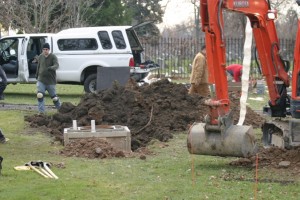 If you wondered why there was a giant dirt pile behind Lyons Hall near Forest Lawn Cemetery, the mystery is solved! During the first week in December, a new vault was built for the Canisius seismograph machine (the Nanometrics Trillium 120P, purchased in 2010). According to Mark Castner, director of the Braun-Ruddick Seismograph Station and adjunct professor of physics, the seismic vault is four foot by four foot square and nearly 11 feet deep, as the station needed to sit on bedrock. But what was equally important to the location (and the reason for the move) was its distance from Main St.
If you wondered why there was a giant dirt pile behind Lyons Hall near Forest Lawn Cemetery, the mystery is solved! During the first week in December, a new vault was built for the Canisius seismograph machine (the Nanometrics Trillium 120P, purchased in 2010). According to Mark Castner, director of the Braun-Ruddick Seismograph Station and adjunct professor of physics, the seismic vault is four foot by four foot square and nearly 11 feet deep, as the station needed to sit on bedrock. But what was equally important to the location (and the reason for the move) was its distance from Main St.
“When I first procured the machine back in 2010 and put it on the pier in the basement of Old Main, I noticed a strange pattern of noise and it wasn’t random,” says Castner. “It didn’t take me long before I went to the web and looked up the subway schedule. The pattern on the screen matched exactly to the subway schedule!”
Castner also tested the machine in the basement of Christ the King Chapel and near the Delavan Townhouses before selecting its current location behind Lyons Hall, which is most ideal because of its distance from Main St. and access to power sources.
“The new machine is extremely sensitive and picks up not only the ground motion of the subway but nearby freight trains and even car traffic, so it’s imperative that we found this new location away from cultural noise,” adds Castner.
Castner received technical assistance for the seismic vault construction from Won-Young Kim, senior research scientist and his team from the Lamont- Doherty Earth Observatory at Columbia University, and help from the Department of Facilities Management. As part of Lamont- Doherty’s seismic network, Canisius already transmits data to Columbia from its new location. You can see the data here: http://www.ldeo.columbia.edu/cgi-bin/LCSN/WebSeis/24hr_heli.pl Select CCNY from the station list at the bottom of the screen and click the SUBMIT button.
Submitted by Marketing & Communication
